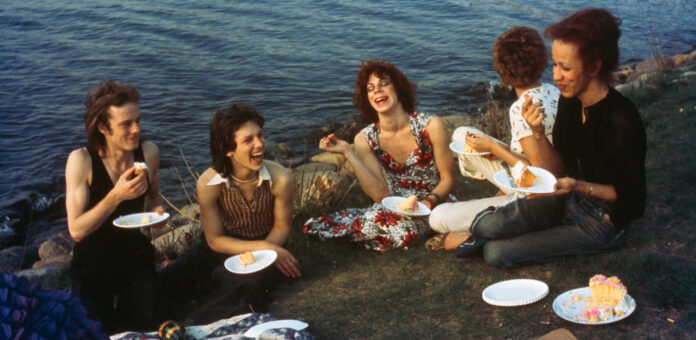Neue Nationalgalerie’s retrospective is the first exhibition in Germany to present a comprehensive overview of Goldin’s work. The exhibition is installed in six unique buildings designed by Hala Wardé, an architect who frequently works with Goldin. Each building is designed in response to the specific piece. Together they constitute a village. “I have always wanted to be a filmmaker. My slideshows are films made up of stills,” says Nan Goldin.
The exhibition is comprised of: The Ballad of Sexual Dependency (1981–2022), her magnum opus; The Other Side (1992– 2021), a historical portrait produced as an homage to her trans friends whom she photographed 1972–2010; Sisters, Saints and Sibyls (2004–2022), a testament to the trauma of families and suicide; Fire Leap (2010–2022), a foray into the world of children; Memory Lost (2019–2021), a claustrophobic journey through drug withdrawal; and Sirens (2019–2020), a trip into drug ecstasy.
The Artist Nan Goldin
Nan Goldin (born in Washington D.C. in 1953) is one of the most high-profile artists of our time. Her work’s exploration of the human experience is legendary and has profoundly influenced subsequent generations. Her first work, The Ballad of Sexual Dependency, documents life in Provincetown, the Lower East Side of New York City, Berlin and London beginning in the 1970s and 80s and up to the present day. Goldin photographed the world of her inner circle of creative, bohemian friends with raw tenderness. Her photographs give us snapshots of intimacy and coupling, the quotidian and wild parties, and the struggle between autonomy and dependency.
The Core of Goldin’s Artistic Practice
Of the generation whose experiences were defined by the freedom of life before AIDS and an alternative world outside normative society, Goldin’s work also stands as a document of the times. Around 1980 Goldin began presenting her slideshows in various clubs and public venues in New York, as well as at underground cinemas and film festivals in Europe. She updated and reedited her slideshow every time and used multiple projectors, which she operated against the background of an eclectic soundtrack. Goldin’s ability to revisit these slideshows has since formed the core of her artistic practice. Over the past 40 years Goldin has produced a dozen different slideshows – from portraits of her friends to accounts of traumatic family events. Since then, she has added elements into her works such as moving images, voices and archival materials.
P.A.I.N. and Ground-breaking Paradigms of Visual Expression
Nan Goldin has always grappled with social issues such as gender, mental health and AIDS, albeit through various approaches. Memory Lost which also forms part of the current exhibition, is an evocation of the darkest sides of drug addiction. In 2017 Goldin founded P.A.I.N. (Prescription Addiction Intervention Now), a direct action group that specifically targeted the Sackler family. The group holds the billionaire family accountable for igniting the epidemic opioid overdose crisis. The Sacklers are a major donor to many prominent international museums. However, many of these institutions have reacted to pressure from P.A.I.N. and removed all trace of the Sackler name from their premises.
Alongside Goldin’s influence on art and the art world, it is also difficult to think of today’s fashion and advertising photography without reflecting on her ground- breaking paradigms of visual expression.
Ironic Humour and Warmth
While the title of the exhibition This Will Not End Well may seem dark and foreboding, it is also full of ironic humour and warmth. The title is an affirmation of what Fredrik Liew, curator for the retrospective, describes as Goldin’s ’characteristically unshakeable joie de vivre.’
Nan Goldin and Berlin
Nan Goldin has a very special relationship with Berlin: the Arsenal cinema showed her Ballad of Sexual Dependency back in 1982. In 1991, she received a DAAD scholarship, moved to the city and has been returning ever since: “The best years of my life were here in Berlin,” Goldin said in 2010. “I don’t say that lightly. I’ve been looking for a home all my life. The only place I feel myself and comfortable and feel real love for my friends is Berlin.”
The International Tour
This Will Not End Well started as a comprehensive international exhibition tour at the Moderna Museet, Stockholm (29 October 2022–26 February 2023), travelled to the Stedelijk Museum in Amsterdam (31 August 2023–28 January 2024) and opens now at the Neue National-galerie in Berlin (23 November 2024–6 April 2025); It continues afterwards to the Pirelli HangarBicocca in Milan (9 October 2025–15 February 2026) and Réunion des musées nationaux – Grand Palais, Paris (March–June 2026).
Exhibition Catalogue and Book
A comprehensive catalogue is produced to accompany the exhibition, with 216 pages, 140 of which are illustrated, and texts by Vince Aletti, Thomas Beard, Guido Costa, Marvin Heiferman, Roni Horn, Patrick Radden Keefe, Caitlín R. Kiernan, Fredrik Liew, Andrea Lissoni, Gabor Maté, Cookie Mueller, Eileen Myles, Alfred Pacquement, Darryl Pinckney, Rene Ricard, Lucy Sante, Sarah Schulman, Anne Swärd, Hala Wardé and David Wojnarowicz. The catalogue is published in English and is distributed internationally by Steidl Verlag.
During the exhibition a limited edition of a book will also be published: a nine-volume series that reproduces all Goldin’s slide shows and multimedia projects including textual work with contributions from various authors, who offer their perspectives on the artist’s voluminous output. Both the catalogue and the book are published by Moderna Museet in collaboration with Steidl Verlag.
Curatorial Direction
The exhibition project is curated by Fredrik Liew, Chief Curator, Moderna Museet.
Educational Programme
A comprehensive educational programme with guided tours, workshops and programs for families, students and adults accompanies the exhibition. It is supported by the Berlin Senate Department for Culture and Social Cohesion and organised by Julia Freiboth and Felicitas Fritsche-Reyrink.
The exhibition is supported by Kvadrat and Sahco.
A special exhibition by the Nationalgalerie – Staatliche Museen zu Berlin
Source : Museen zu Berlin













